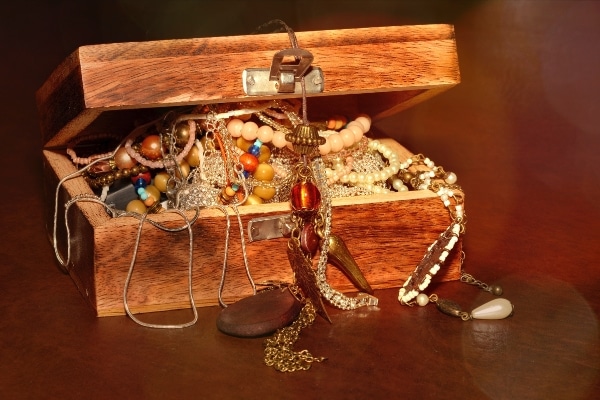
The words ‘decluttering’ and ‘downsizing’ can have negative connotations. They imply loss and restriction – the world and everything in it is shrinking. On the other hand, a treasure hunt suggests adventure, excitement, and new possibilities. Here are some ways to turn the chore of downsizing into an exciting experience.
What Is Considered a Treasure?
Most people think of searching for gems and gold in a jewelry box. There are also stories of people finding rare – and valuable – comic books hidden in attics. But value can also be measured by emotional attachment. Photos and memorabilia may not be worth much on the open market; however, they may help explain family history.
When to Start the Treasure Hunt
The book, The Gentle Art of Swedish Death Cleaning, suggests people should think about downsizing when they are around the age of retirement or shortly after their children move out. That might seem too early for some. But if you have more time to search for treasures, you are more likely to find them. Then you can share them with others.
You can’t do a treasure hunt in one day – nor should you try. For example, archeological digs involve careful, deliberate work. When scientists find artifacts, they carefully evaluate them before deciding what to do with them. Likewise, you can do the same. Start with one space such as a small room, closet, or just a drawer or shelf. Assess each item and decide if you will keep it or let it go (consign, classified, charity, etc.).
What to Look For
Look for things that “spark joy” for you. However, someone else might love an item you consider tacky. As the old saying goes, “one person’s trash is another person’s treasure,” so don’t discount that ugly lamp or outdated brooch. If you don’t want it, set it aside. Here are a few treasures you might want to hunt for.
Jewelry: Whether it’s a pure gold necklace or inexpensive costume jewelry, consider it a treasure if you think it’s beautiful and will wear it regularly. Learn more about how to clear your jewelry box.
Home Décor: Some knickknacks, vases, lamps, and home décor items can fetch a fair price even if you think it’s the tackiest thing ever made. But, if you think it is beautiful and you love it, feel free to keep and appreciate it!
Paper: You can put most old magazines (like that National Geographic collection from the 1970s) and newspapers into the recycling bin. However, some collectors adore vintage magazines, travel posters, movie tickets, and theatre playbills and programs. Do a quick internet search to see if anyone is interested in any unique treasures you have.
When searching through papers, keep an eye out for financial and legal documents such as stock certificates, bonds, insurance policies, and uncashed cheques. Check with your bank or financial adviser to see if they can be converted to cash and deposited into your account.
Old Fashioned Sporting Goods: Aficionados often seek out old-fashioned bicycles, antique tennis rackets, vintage team jerseys, camping equipment, etc. Some people get joy from restoring these items, too, so even old pieces and parts may have some value in the right market.
Retro Toys, Games and Collectibles: There is a huge market for board games and toys from the past. From Lego® blocks to Fisher-Price Little People® playsets, to Star Wars® lunch boxes. If it is in fairly good condition, it could be a treasure.
Vintage Electronics: Old cameras, computers, video game systems, movie projectors, radios and more – electronics enthusiasts love the challenge of restoring them. Living history museums and theatre set designers may be looking for period pieces in good exterior condition even if they don’t function.
Tools and Hobby Equipment: If you are downsizing, you may not have space in your new home for some of the larger tools and hobby equipment you currently own. Let the quilting frame, scrapbooking supplies, table saw, and carpentry tools go to someone who will use them.
Where to Look for Treasures
Sometimes people hide valuables in secret places – so secret, in fact, that they can’t remember where those places are. It is essential to expand your treasure hunt and look in areas that might not seem that logical, including:
- Inside clothing (pockets, lining, waistbands, built-in bras, etc.)
- Between curtains and lining.
- Inside and underneath furniture and mattresses.
- Inside cans, jars, water bottles, etc., including what is in the fridge or freezer. (A friend told me her great-grandfather had $20,000 cash stored inside coffee cans).
- Between books or within the pages of books.
- Behind framed artwork. (Besides hiding money and sensitive documents, occasionally, someone will put a modern picture in the frame in front of an older valuable painting or print.)
- Inside old electronics and appliances (clocks, vacuum cleaners, televisions, speakers, etc.)
A downsizing treasure hunt can be a lot of fun, especially if you can involve family members and take a few trips down memory lane at the same time. However, if you feel a little overwhelmed, feel free to contact the Out of Chaos team. We would love to help you hunt for treasures.
Image by rawpixel.
